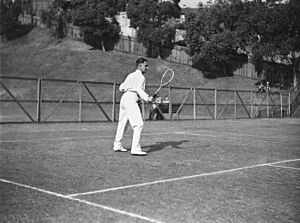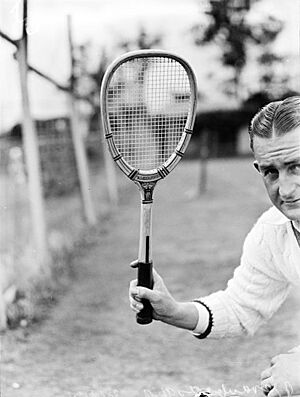Jack Crawford (tennis) facts for kids
 |
|
| Full name | John Herbert Crawford |
|---|---|
| Country (sports) | |
| Born | 22 March 1908 Urangeline, New South Wales, Australia |
| Died | 10 September 1991 (aged 83) Sydney, New South Wales, Australia |
| Height | 1.85 m (6 ft 1 in) |
| Turned pro | 1926 (amateur tour) |
| Retired | 1951 |
| Plays | Right-handed (one-handed backhand) |
| Int. Tennis HoF | 1979 (member page) |
| Singles | |
| Career record | 681-182 (78.9%) |
| Career titles | 66 |
| Highest ranking | No. 1 (1933, A. Wallis Myers) |
| Grand Slam singles results | |
| Australian Open | W (1931, 1932, 1933, 1935) |
| French Open | W (1933) |
| Wimbledon | W (1933) |
| US Open | F (1933) |
| Doubles | |
| Grand Slam doubles results | |
| Australian Open | W (1929, 1930, 1932, 1935) |
| French Open | W (1935) |
| Wimbledon | W (1935) |
| US Open | F (1939) |
| Grand Slam mixed doubles results | |
| Australian Open | W (1931, 1932, 1933) |
| French Open | W (1933) |
| Wimbledon | W (1935) |
Jack Crawford (born March 22, 1908, died September 10, 1991) was a famous Australian tennis player from the 1930s. He was ranked the world's best amateur player in 1933. That year, he won three major tournaments: the Australian Open, the French Open, and Wimbledon. He almost won all four major tournaments, known as the Grand Slam, but he lost in the final of the U.S. Open by just one set.
He also won the Australian Open in 1931, 1932, and 1935. Later, in 1979, he was honored by being added to the International Tennis Hall of Fame.
Contents
Early Life and Junior Career
Jack Crawford was born on March 22, 1908, in a place called Urangeline, near Albury, Australia. He was one of the younger children of Jack Sr. and Lottie Crawford.
He didn't have formal tennis lessons when he was young. Instead, he practiced by hitting a ball against his house or school walls. He also played tennis with his older brother.
Jack played his first official tennis match at age 12. It was a mixed doubles match at the Haberfield club. He won the Australian junior championships four times in a row. This happened from 1926 to 1929, and he got to keep the trophy forever.
Jack Crawford's Tennis Career
Jack Crawford won many important tennis titles. However, he is perhaps most famous for something he almost did. In 1933, he nearly completed the tennis Grand Slam. This was five years before Don Budge achieved it for the first time in 1938.
The Grand Slam Attempt of 1933
In 1933, Jack won the Australian Championships, French Championships, and Wimbledon Championships. This meant he only needed to win the U.S. Championships to complete the Grand Slam.
Jack had asthma, which made it hard for him to breathe in hot, humid weather. The final of the U.S. Championships was in muggy Forest Hills. He was playing against the English player Fred Perry. Jack was ahead by two sets to one when he started to lose his energy.
People said Jack often drank brandy mixed with sugar to help his breathing during matches. On that hot afternoon, he was said to have had a few doses of this drink. However, there are different stories about what he actually drank. In the end, Jack lost the match with a score of 3–6, 13–11, 6–4, 0–6, 1–6.
World Number One Ranking
In 1933, many tennis experts ranked Jack Crawford as the World No. 1 amateur player. These experts included A. Wallis Myers, Bernard Brown, and Harry Hopman.
Later Career and Achievements
Jack got some revenge against Fred Perry at the 1935 Australian Open. He won the final against Perry in four sets. This was his tenth major final in a row, a record only matched by Bill Tilden and later by Roger Federer.
He reached his last Australian Open finals in 1936 and 1940. In both matches, he lost to fellow Australian Adrian Quist. Jack set a record by reaching seven Australian Open finals, which was later equaled by Roy Emerson in 1967.
In his 1979 book, Jack Kramer, a famous tennis promoter and player, listed Jack Crawford among the 21 greatest players of all time.
Jack Crawford was honored in the International Tennis Hall of Fame in 1979. He was also added to the Australian Tennis Hall of Fame in 1997. In 1977, he was made an Officer of the Order of the British Empire (OBE) for his contributions to sports.
Playing Style
Jack Crawford was a right-handed player who mostly played from the back of the court. His game was known for its technical skill and accuracy, rather than powerful shots. He wasn't super fast, but he was very good at guessing where the ball would go. His playing style was described as smooth and easy.
His style was compared to that of Henri Cochet, another famous tennis player. Jack always wore long, white, neatly pressed pants and a long-sleeved shirt. He used an old-fashioned flat-topped racket. This racket was made by the Alexander Patent Racket Company in Launceston, Tasmania.
Grand Slam Tournament Finals
Jack Crawford played in many Grand Slam finals. Here are his results:
Singles: 12 Finals (6 Wins, 6 Losses)
| Result | Year | Championship | Surface | Opponent | Score |
|---|---|---|---|---|---|
| Win | 1931 | Australian Championships | Grass | 6–4, 6–2, 2–6, 6–1 | |
| Win | 1932 | Australian Championships | Grass | 4–6, 6–3, 3–6, 6–3, 6–1 | |
| Win | 1933 | Australian Championships | Grass | 2–6, 7–5, 6–3, 6–2 | |
| Win | 1933 | French Championships | Clay | 8–6, 6–1, 6–3 | |
| Win | 1933 | Wimbledon Championships | Grass | 4–6, 11–9, 6–2, 2–6, 6–4 | |
| Loss | 1933 | U.S. Championships | Grass | 3–6, 13–11, 6–4, 0–6, 1–6 | |
| Loss | 1934 | Australian Championships | Grass | 3–6, 5–7, 1–6 | |
| Loss | 1934 | French Championships | Clay | 4–6, 9–7, 6–3, 5–7, 3–6 | |
| Loss | 1934 | Wimbledon Championships | Grass | 3–6, 0–6, 5–7 | |
| Win | 1935 | Australian Championships | Grass | 2–6, 6–4, 6–4, 6–4 | |
| Loss | 1936 | Australian Championships | Grass | 2–6, 3–6, 6–4, 6–3, 7–9 | |
| Loss | 1940 | Australian Championships | Grass | 3–6, 1–6, 2–6 |
Doubles: 12 Finals (6 Wins, 6 Losses)
| Result | Year | Championship | Surface | Partner | Opponents | Score |
|---|---|---|---|---|---|---|
| Win | 1929 | Australian Championships | Grass | 6–1, 6–8, 4–6, 6–1, 6–3 | ||
| Win | 1930 | Australian Championships | Grass | 8–6, 6–1, 2–6, 6–3 | ||
| Loss | 1931 | Australian Championships | Grass | 2–6, 4–6, 3–6 | ||
| Win | 1932 | Australian Championships | Grass | 12–10, 6–3, 4–6, 6–4 | ||
| Loss | 1933 | Australian Championships | Grass | 4–6, 8–10, 2–6 | ||
| Loss | 1934 | French Championships | Grass | 9–11, 3–6, 6–2, 6–4, 7–9 | ||
| Win | 1935 | Australian Championships | Grass | 6–4, 8–6, 6–2 | ||
| Win | 1935 | French Championships | Clay | 6–1, 6–4, 6–2 | ||
| Win | 1935 | Wimbledon Championships | Grass | 6–3, 5–7, 6–2, 5–7, 7–5 | ||
| Loss | 1936 | Australian Championships | Grass | 8–6, 2–6, 1–6, 6–3, 2–6 | ||
| Loss | 1939 | U.S. Championships | Grass | 6–8, 1–6, 4–6 | ||
| Loss | 1940 | Australian Championships | Grass | 3–5, 5–7, 1–6 |
Mixed Doubles: 8 Finals (5 Wins, 3 Losses)
| Result | Year | Championship | Surface | Partner | Opponents | Score |
|---|---|---|---|---|---|---|
| Loss | 1928 | Wimbledon Championships | Grass | 5–7, 4–6 | ||
| Loss | 1929 | Australian Championships | Grass | 6–0, 7–5 | ||
| Loss | 1930 | Australian Championships | Grass | 9–11, 6–3, 3–6 | ||
| Win | 1930 | Wimbledon Championships | Grass | 6–1, 6–3 | ||
| Win | 1931 | Australian Championships | Grass | 7–5, 6–4 | ||
| Win | 1932 | Australian Championships | Grass | 6–8, 8–6, 6–3 | ||
| Win | 1933 | Australian Championships | Grass | 3–6, 7–5, 13–11 | ||
| Win | 1933 | French Championships | Clay | 6–2, 6–3 |
See Also
- List of male tennis players
- Tennis records of All Time – Men's singles



